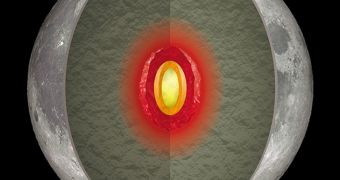It's impossible to tell just by looking at it, but by the looks of it, our Moon has one very soft side that it likes to keep to itself. Thus, astronomers say that our planet's satellite packs a surprisingly soft layer on the inside, as shown in the image next to this article.
What's more, evidence at hand indicates that the gravitational pull exerted by our planet on the Moon causes this layer to heat up. This phenomenon explains the satellite's current shape, a paper in the journal Nature Geoscience argues.
In this paper, researchers led by Dr. Yuji Harada with China's University of Geosciences detail that, in order to gain a better understanding of the anatomy of our planet's satellite, they looked at data concerning the deformation of the Moon.
The end goal was to establish how its appearance has been altered over the years by external forces acting on it. Based on these changes in the Moon's shape, the scientists were able to infer the makeup of its interior, which cannot be observed directly.
As detailed by Phys Org, information obtained in this manner led the scientists behind this research project to the conclusion that the Moon is not one solid piece of rock through and through. On the contrary, it appears that its interior has not yet cooled and hardened completely.
Writing in the journal Nature Geoscience, the specialists go on to explain that, according to their investigations into the matter at hand, the Earth's gravitational pull causes tides to manifest themselves inside the Moon. These tides are believed to generate heat.
Commenting on these findings, Prof. Junichi Haruyama points out that, “A smaller celestial body like the Moon cools faster than a larger one like the Earth does. In fact, we had thought that volcanic activities on the Moon had already come to a halt. Therefore, the Moon had been believed to be cool and hard, even in its deeper parts.”
“However, this research tells us that the Moon has not yet cooled and hardened, but is still warm. It even implies that we have to reconsider the question as follows: How have the Earth and the Moon influenced each other since their births?” the researcher goes on to add.
Dr. Yuji Harada and colleagues wish to further investigate the Moon's anatomy and hope to soon gain a better understanding of the makeup of this soft layer. Thus, they plan to study heat-generating mechanisms inside the Moon in detail. These studies are expected to help shed new light on the interactions between Earth and this satellite.

 14 DAY TRIAL //
14 DAY TRIAL //